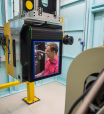
Chronic kidney disease of unknown origin
In 2017, ANSTO's CEO signed a Memorandum of Understanding with Sri Lanka to work together to investigate the epidemiology of Chronic Kidney Disease of unknown origin (CKDu).

Showing 21 - 40 of 116 results

In 2017, ANSTO's CEO signed a Memorandum of Understanding with Sri Lanka to work together to investigate the epidemiology of Chronic Kidney Disease of unknown origin (CKDu).

ANSTO's OPAL reactor is one of the world's most advanced and reliable research reactors today. To ensure we can continue operating OPAL safely and reliably and maximise utilisation, ANSTO must regularly carry out maintenance and upgrades.

This scholarship recognises outstanding ability and promise in the field of nuclear science and technology, specifically as it applies to nuclear energy. Successful applicants will demonstrate a history of interest in nuclear energy and a desire to continue this interest.
Electron and X-ray diffraction techniques provide insights into material damage under stress-strain conditions.
A new imaging technology developed at ANSTO makes it possible to image, identify and locate gamma-ray radiation in a safe and timely manner.

Frequently asked questions about ANSTO for the community.

The High Performance Macromolecular Crystallography beamline will enable the study of very small (sub-5 micrometre) or weakly diffracting crystals, providing a state-of-the-art high-throughput facility for researchers. MX3 will be able to study the structures of large proteins and protein complexes for virology, drug design and industrial applications via goniometer mounted crystals, in-tray screening, or via serial crystallography methods.
Thirty years of ANSTO's unique capability in monitoring fine particle pollution provides insight on bushfire smoke.
A new continuous record of temperature dating back 12,000 years provides an import resource in understanding current and future climate changes,
Publications, posters and conference presentations for fire impacts reconstructed from a southwest Australian stalagmite.
The X-ray Fluorescence Nanoprobe beamline undertakes high-resolution X-ray microspectroscopy, elemental mapping and coherent diffraction imaging – providing a unique facility capable of spectroscopic and full-field imaging. Elemental mapping and XANES studies will be possible at sub-100 nm resolution, with structural features able to be studied down to 15 nm using scanning X-ray diffraction microscopy.
With world-class experts in groundwater and major contributions in this area over two decades, ANSTO completed a major project report on Improving groundwater sustainability and renewability using isotope hydrochemistry in NSW for the Department of Planning and Environment (NSW) and National Water Grid earlier in the year.
Expertise in the use of PET and SPECT imaging techniques to understand biological processes at the cellular and molecular level. The techniques ae also used to study disease processes and monitor the effects of new therapies
The health impacts of exposure to poor levels of air quality resulting from bushfires and drought recommended that NSW Government work with ANSTO to expand the sampling of particulate matter in the air state-wide.
The technique of using radiocarbon to establish the age of artefacts and other samples as well as to provide insights on climate, has just been updated with the publication of the new radiocarbon curves.


With enhanced submicron spatial resolution, speed and contrast, the Micro-Computed Tomography beamline opens a window on the micron-scale 3D structure of a wide range of samples relevant to many areas of science including life sciences, materials engineering, anthropology, palaeontology and geology. MCT will be able to undertake high-speed and high-throughput studies, as well as provide a range of phase-contrast imaging modalities.